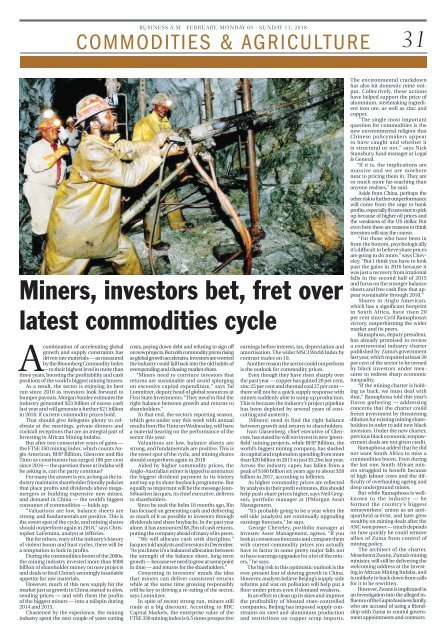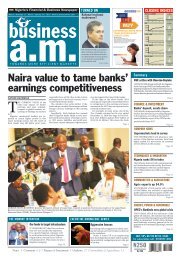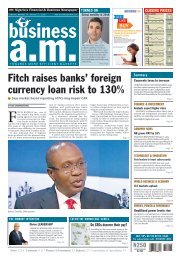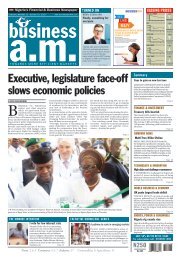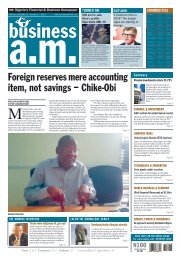You also want an ePaper? Increase the reach of your titles
YUMPU automatically turns print PDFs into web optimized ePapers that Google loves.
BUSINESS A.M. FEBRUARY, MONDAY <strong>05</strong> - SUNDAY 11, 20<strong>18</strong><br />
COMMODITIES & AGRICULTURE<br />
31<br />
Miners, investors bet, fret over<br />
latest commodities cycle<br />
A<br />
combination of accelerating global<br />
growth and supply constraints has<br />
driven raw materials — as measured<br />
by the Bloomberg Commodity Index<br />
— to their highest level in more than<br />
three years, boosting the profitability and cash<br />
positions of the world’s biggest mining houses.<br />
As a result, the sector is enjoying its best<br />
run since 2010 as investors look forward to<br />
bumper payouts. Morgan Stanley estimates the<br />
industry generated $23 billion of excess cash<br />
last year and will generate a further $21 billion<br />
in 20<strong>18</strong>, if current commodity prices hold.<br />
That should give delegates plenty to celebrate<br />
at the meetings, private dinners and<br />
cocktail receptions that are an integral part of<br />
Investing in African Mining Indaba.<br />
But after two consecutive years of gains —<br />
the FTSE 350 mining index, which counts Anglo<br />
American, BHP Billiton, Glencore and Rio<br />
Tinto as constituents has surged <strong>18</strong>6 per cent<br />
since 2016 — the question those at Indaba will<br />
be asking is, can the party continue?<br />
For many the answer is yes, as long as the industry<br />
maintains shareholder friendly policies<br />
that place profits and dividends above megamergers<br />
or building expensive new mines,<br />
and demand in China — the world’s biggest<br />
consumer of commodities — holds up.<br />
“Valuations are low, balance sheets are<br />
strong, and fundamentals are positive. This is<br />
the sweet spot of the cycle, and mining shares<br />
should outperform again in 20<strong>18</strong>,” says Christopher<br />
LaFemina, analyst at Jefferies.<br />
But for others, wary of the industry’s history<br />
of violent boom and bust cycles, there will be<br />
a temptation to lock in profits.<br />
During the commodities boom of the 2000s,<br />
the mining industry invested more than $900<br />
billion of shareholder money on new projects<br />
and deals to feed China’s seemingly insatiable<br />
appetite for raw materials.<br />
However, much of this new supply hit the<br />
market just as growth in China started to slow,<br />
sending prices — and with them the profits<br />
of the biggest miners — into a tailspin during<br />
2014 and 2015.<br />
Chastened by the experience, the mining<br />
industry spent the next couple of years cutting<br />
costs, paying down debt and refusing to sign off<br />
on new projects. But with commodity prices rising<br />
as global growth accelerates, investors are worried<br />
the industry could fall back into the old habits of<br />
overspending and chasing market share.<br />
“Miners need to convince investors that<br />
returns are sustainable and avoid splurging<br />
on excessive capital expenditure,” says Tal<br />
Lomnitzer, deputy head of global resources at<br />
First State Investments. “They need to find the<br />
right balance between growth and returns to<br />
shareholders.”<br />
To that end, the sector’s reporting season,<br />
which gets under way this week with annual<br />
results from Rio Tinto on Wednesday, will have<br />
a material bearing on the performance of the<br />
sector this year.<br />
Valuations are low, balance sheets are<br />
strong, and fundamentals are positive. This is<br />
the sweet spot of the cycle, and mining shares<br />
should outperform again in 20<strong>18</strong><br />
Aided by higher commodity prices, the<br />
Anglo-Australian miner is tipped to announce<br />
the biggest dividend payment in its history<br />
and top up its share buyback programme. But<br />
equally as important will be the message Jean-<br />
Sébastien Jacques, its chief executive, delivers<br />
to shareholders.<br />
Since he took the helm <strong>18</strong> months ago, Rio<br />
has focused on generating cash and delivering<br />
as much of it as possible to investors through<br />
dividends and share buybacks. In the past year<br />
alone, it has announced $8.2bn of cash returns,<br />
putting the company ahead of many of its peers.<br />
“We will allocate cash with discipline,”<br />
Jacques told analysts and investors in December.<br />
“As you know it’s a balanced allocation between<br />
the strength of the balance sheet, long-term<br />
growth — because we need to grow at some point<br />
in time — and returns for the shareholders.”<br />
Cementing in investors’ minds the idea<br />
that miners can deliver consistent returns<br />
while at the same time growing responsibly<br />
will be key to driving a re-rating of the sector,<br />
says Lomnitzer.<br />
In spite of recent strong run, miners still<br />
trade at a big discount. According to RBC<br />
Capital Markets, the enterprise value of the<br />
FTSE 350 mining index is 6.5 times prospective<br />
earnings before interest, tax, depreciation and<br />
amortisation. The wider MSCI World Index by<br />
contrast trades on 10.<br />
Another reason the sector could outperform<br />
is the outlook for commodity prices.<br />
Even though they have risen sharply over<br />
the past year — copper has gained 20 per cent,<br />
zinc 25 per cent and thermal coal 27 per cent —<br />
there will not be a quick supply response with<br />
miners suddenly able to ramp up production.<br />
This is because the industry’s project pipeline<br />
has been depleted by several years of costcutting<br />
and austerity.<br />
[Miners] need to find the right balance<br />
between growth and returns to shareholders.<br />
Ivan Glasenberg, chief executive of Glencore,<br />
has stated he will not invest in new ‘greenfield’<br />
mining projects, while BHP Billiton, the<br />
world’s biggest mining company, has slashed<br />
its capital and exploration spending from more<br />
than $20 billion in 2013 to just $5.2bn last year.<br />
Across the industry capex has fallen from a<br />
peak of $160 billion six years ago to about $50<br />
billion in 2017, according to Jefferies.<br />
As higher commodity prices are reflected<br />
by analysts in their profit estimates, this should<br />
help push share prices higher, says Neil Gregson,<br />
portfolio manager at JPMorgan Asset<br />
Management.<br />
“It’s probably going to be a year when the<br />
sell side [analysts] are continually upgrading<br />
earnings forecasts,” he says.<br />
George Cheveley, portfolio manager at<br />
Investec Asset Management, agrees. “If you<br />
look at consensus forecasts and compare them<br />
with current commodity prices you actually<br />
have to factor in some pretty major falls not<br />
to have earnings upgrades for a lot of the miners,”<br />
he says.<br />
The big risk to this optimistic outlook is the<br />
ever-present fear of slowing growth in China.<br />
However, analysts believe Beijing’s supply-side<br />
reforms and war on pollution will help put a<br />
floor under prices even if demand weakens.<br />
In an effort to clean up its skies and improve<br />
the profitability of bloated state-controlled<br />
companies, Beijing has imposed supply constraints<br />
on steel and aluminium production<br />
and restrictions on copper scrap imports.<br />
The environmental crackdown<br />
has also hit domestic mine output.<br />
Collectively, these actions<br />
have helped support the price of<br />
aluminium, steelmaking ingredient<br />
iron ore, as well as zinc and<br />
copper.<br />
“The single most important<br />
question for commodities is the<br />
new environmental religion that<br />
Chinese policymakers appear<br />
to have caught and whether it<br />
is structural or not,” says Nick<br />
Stansbury, fund manager at Legal<br />
& General.<br />
“If it is, the implications are<br />
massive and we are nowhere<br />
near to pricing them in. They are<br />
so much more far-reaching than<br />
anyone realises,” he said.<br />
Aside from China, perhaps the<br />
other risk to further outperformance<br />
will come from the urge to bank<br />
profits, especially if costs start to pick<br />
up because of higher oil prices and<br />
the weakness of the US dollar. But<br />
even here there are reasons to think<br />
investors will stay the course.<br />
“For those who have been in<br />
from the bottom, psychologically<br />
it’s difficult to believe share prices<br />
are going to do more,” says Cheveley.<br />
“But I think you have to look<br />
past the gains in 2016 because it<br />
was just a recovery from irrational<br />
falls in the second half of 2015<br />
and focus on the stronger balance<br />
sheets and free cash flow that appear<br />
sustainable through 20<strong>18</strong>.”<br />
Shares in Anglo American,<br />
which has a significant footprint<br />
in South Africa, have risen 20<br />
per cent since Cyril Ramaphosa’s<br />
victory, outperforming the wider<br />
market and its peers.<br />
Ramaphosa, deputy president,<br />
has already promised to review<br />
a controversial industry charter<br />
published by Zuma’s government<br />
last year, which required at least 30<br />
per cent of the sector to be owned<br />
by black investors under measures<br />
to redress sharp economic<br />
inequality.<br />
“If the mining charter is holding<br />
us back, we must deal with<br />
that,” Ramaphosa told this year’s<br />
Davos gathering — addressing<br />
concerns that the charter could<br />
freeze investment by threatening<br />
dilution for existing mining shareholders<br />
in order to add new black<br />
investors. Under the new charter,<br />
previous black economic empowerment<br />
deals are not given credit.<br />
Ramaphosa added that he did<br />
not want South Africa to miss a<br />
commodities boom. Even during<br />
the last one, South African miners<br />
struggled to benefit because<br />
of high labour costs and the difficulty<br />
of overhauling ageing and<br />
deep underground mines.<br />
But while Ramaphosa is wellknown<br />
to the industry — he<br />
formed the country’s biggest<br />
mineworkers’ union as an antiapartheid<br />
activist, and later grew<br />
wealthy on mining deals after the<br />
ANC won power — much depends<br />
on how quickly he could remove<br />
allies of Zuma from control of<br />
mining policy.<br />
The architect of the charter,<br />
Mosebenzi Zwane, Zuma’s mining<br />
minister, will still be delivering the<br />
welcoming address at the Investing<br />
in African Mining Indaba, and<br />
is unlikely to back down from calls<br />
for it to be rewritten.<br />
However, Zwane is implicated in<br />
an investigation into the alleged influence<br />
of the Gupta business family,<br />
who are accused of using a friendship<br />
with Zuma to control government<br />
appointments and contracts.


